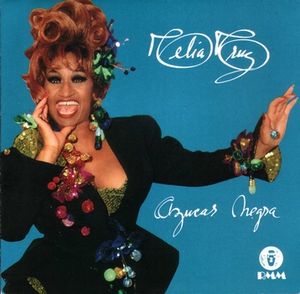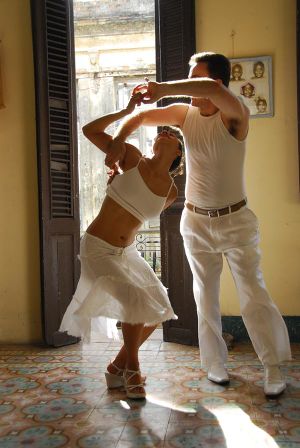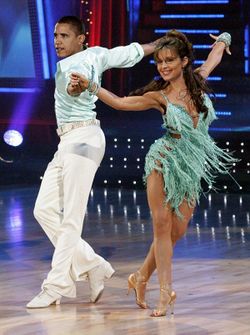Salsa music

Salsa is a Latin-American musical style characterized by complex arrangements using diverse instruments such as pianos, trumpets, bongos, kitchen cutlery, tomatoes, onions, chilies, beans, corn, and various spices.
The rebranding in 1937 of what was originally called "mambo" was a stroke of marketing genius by the original Mambo King, Tito Puente, who recognized that rhythmically challenged gringos people of non-Latino descent associate "salsa" with "hot", and by extension with anything that makes them look even more hopelessly white cool. In a similar flash of brilliance, famed percussionist Guillermo Férrel infused salsa with its trademark cowbell, securing its adoption by the Ruler of the Known Universe, Christopher Walken.
"Salsa" is also a generic term for various sauces found in Latin cuisine. However, since this is not the type of salsa that can lead to the horizontal mambo, it is of no interest here.[1]
Music
History
The salsa genre traces its roots back to the 1930's from the Cuban son, though it is unclear exactly whose child this refers to. In any case, Afro-Cuban rhythms were imported into the United States, and in the grand tradition of cooking up quasi-foreign curiosities such as chop suey and fake Rolex watches, salsa was born in the musical mecca of New York City.
After the Cuban Missile Crisis and subsequent U.S. trade embargo against Cuba, musicians in Nueva York turned to Colombia as their main source of salsa inspiration. Importation of Colombian music was simple at first until gringo protectionists, fearing damage to the American chitlin industry by a flood of imported haggis,[2] successfully passed the Mitigation of Imports Via Embargo and Restriction of Goods Act of 1966 (MI VERGA). This forced salseros to smuggle Colombian music into the country in shipments of cocaine. The arrangement was successful for many years until U.S. law enforcement recognized that the country would be safer if it had fewer drug addicts than rapists and murderers, and focused its resources on seizing imported contraband.
It was at this point that famed recording studio Fania Records researched American cultural awareness and discovered that 94% of gringos viewed all of Latin America as a homogeneous cultural blob. This meant that salseros could import music from the U.S. state of Puerto Rico, not subject to the otherwise extensive reach of MI VERGA,[3] and use it as a yanqui-friendly substitute for Colombian music. This revelation lead to the birth of boricua-inspired salsa.[4]
Salsa today is thus an amalgam of many traditional Latin musical styles. In this way, it is as rich in heritage as zydeco, but thankfully without the accordion.
Salsa today
Salsa lyrics have historically covered a wide range of important topics, such as pride and prejudice,[5] slavery,[6] and footsie under the table.[7] During the 1980's and 90's, the pornographic sensual salsa romántica took root, tackling relevant issues such as getting naked[8] and asking for blowjobs.[9] The lines have since blurred between salsa romántica and the older salsa dura ("hard salsa", which comes pre-blown), with modern salsa taking on profound subjects such as where salsa is played,[10] who plays the best salsa,[11] and how fun it is to dance salsa.[12]
Salsa music has enjoyed a healthy increase in popularity since the 1960's and is widely available on the Internet. Despite this, it is still hard to find at a traditional music store in the United States. This is because the música Latina section at most stores is dominated by banda and norteña music due to cultural influence from Mexico, even though associating these genres with salsa is like categorizing Miley Cyrus with the Boston Symphony Orchestra. Moreover, this section is often stocked by teenage gringos who believe Jennifer Lopez is the epitome of Latin music.
Dancing
Social norms

Salsa dancing is a popular swingers' social activity. Most salsa clubs will host a free dance lesson before they start "open dancing" (a term coined by analogy with "open marriage"). The purpose of the lesson is to give beginners a false sense of confidence that they've actually learned something before the regular crowd arrives, kidnaps their gringas and subjects them to male lap dancing. When a newbie male sees two seasoned dancers and says, "I wish I could tap that!"[13] it is the perfect opportunity for the instructor to market his or her $100-per-hour private salsa lessons.
As with other partner dances, the onus is traditionally on the man to ask a woman to dance. Of course, it is perfectly acceptable for a woman to ask a man; this is in fact an essential skill for any woman over (a body mass index of) 30. In most cases, men are asked based on their actual ability, whereas women are asked based on their physical similarity to Penelope Cruz. Requesting a dance demands as much nimbleness as dancing itself, since the start of every song is typified by a mad scramble to snag a desirable partner before only the ones who move like Al Gore and look like Janet Reno are left.
Technique
The most common form of salsa dancing is based on a 6-count step to 8-count music, which is why salsa dancers get confused when you hand them four or eight of anything. It is danced "in the slot" meaning that the man and woman travel in a straight line back and forth.[14] In theory, the geometric consistency of the slot shape should allow many couples to fit on a dance floor without crashing into each other, like a neatly organized tangram; unfortunately, most salseros do not understand this since tangrams are a Chinese concept. As with most other Latin dances, proper salsa technique involves the use of birth control, unless you are dancing with yourself.
Styles
Club-style salsa is divided into two broad categories called "L.A. style" and "New York style", also known respectively as on 1 and on 2. These latter terms refer to dance-step timing, i.e., which musical beat is emphasized by the "break" step. N00bz Salseros who otherwise eschew dancing to an actual beat may nonetheless employ (and even mix) timing patterns such as on 3, on 4 and the innovative on π. Note that on 1, on 2, on 3, etc. are unrelated to the similar terms in horizontal mambo.
Another popular style is salsa rueda or casino rueda, in which casineros dance in the round while switching partners as an emcee calls out moves. This is similar to American square dancing — the main differences being that rueda features callouts in Spanish, while square dancing is a clinically recognized form of contraception.
Ethnic considerations
As ambassadors to all things Latino, people of Hispanic descent are required by international law to learn salsa dancing. Since most Latin-American children learn to salsa before even being able to walk, inconveniences such as paraplegia, quadriplegia and amputation are generally not considered valid exemptions. Mexicans however may claim an exemption, since the banda/norteña gene (B4DTA5TE) is by and large incompatible with the salsa gene (H0TRHY7HM).
The salsa gene is closely linked to others common in the Latin population. Any Latino displaying an inability to dance salsa should immediately be taken to a medical facility for genetic testing, as this may be a sign of other rare conditions such as infertility, punctuality and Republicanism.
Related dances
Salsa clubs feature other styles of music commonly played between salsa sets:
- Cha-cha-cha (or cha-cha for those running late to a siesta) is similar to salsa, but slower. This would supposedly allow even Kosmo Kramer to dance it, except that the slower tempo gives instructors room to insert even more gringo-confusing steps. Cha-cha music is featured in the wholesome butt-wiping bear commercials by Cha-Cha-Charmin, a company even more obsessed with big butts than Sir Mix-A-Lot.
- Merengue has a
monotonoussimple two-count rhythm, allowing all merengue songs to be samples and covers of each other. It is matched by an equally simple two-count dance step, easy enough for Stephen Hawking to dance. In addition, merengue features a unique "break step", where the real dancers step off the floor to take a break. - Bachata is the modern "forbidden dance" where a couple imagines a $100 bill wedged between the man's right thigh and lady's crotch, then tries to dance an entire song without dropping it to the floor. Like merengue, bachata is a product of the Dominican Republic, designed to help its people procreate faster than Haitians and thus crowd them off the island of Hispaniola.
Uniting the world
Though Latin in origin, salsa's following is truly a demographic melting pot, where one might see David Duke dancing with Rosa Parks, Rush Limbaugh with Hillary Clinton, or your son with Pamela Smart. With the power to bring people of all races, ages and persuasions together, salsa holds the promise of a world where gringos love immigrants, Christians love Muslims, everybody loves Jews, Americans love soccer, blacks love hockey, and Texans love gun control. Salseros everywhere hope that one day they can do their part to make this dream a reality.
See also
Footnotes
- ↑ Note that mambo is the precursor to salsa, while horizontal mambo is the precursor to salsa blanca.
- ↑ It was around this time when Japan started making better cars than Detroit, Greece better butt-lovers than San Francisco, and Paris better pricks than New York.
- ↑ In truth, enforcement was lax as trade inspectors paid mostly lip service to MI VERGA. It was dealt a sizable blow in '69 when the U.S. Supreme Court voted in favor of its discharge.
- ↑ Puerto Ricans proudly bear the name of the indigenous boricua as their own – like the Indians and Redskins but without the racism.
- ↑ "Han cogida la cosa" lyrics
- ↑ "Rebelión" lyrics
- ↑ "Una aventura" lyrics
- ↑ "Desnúdate, mujer" lyrics
- ↑ "Devórame otra vez" lyrics
- ↑ "Un verano en Nueva York" lyrics
- ↑ "Verdaderos soneros" lyrics
- ↑ "La banda" lyrics
- ↑ 89% of men who take salsa lessons do so for the chance to grope hot women in public without getting slapped. The other 11% are gay.
- ↑ As opposed to mambo in the slot where the man travels in and out



